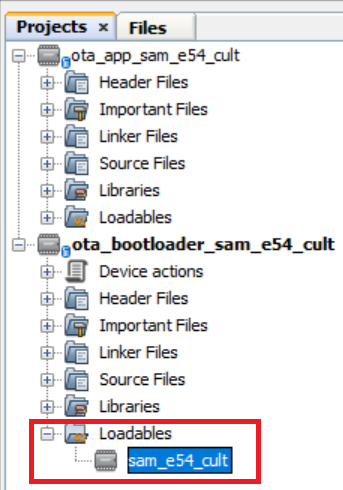1.1.3 SAM E54 Curiosity Ultra Development Board: Building and Running the OTA Bootloader applications
Downloading and building the application
To clone or download this application from Github,go to the main page of this repository and then click Clone button to clone this repo or download as zip file. This content can also be download using content manager by following these instructions
Path of the application within the repository is apps/ble/dual_bank/
To build the application, refer to the following table and open the project using its IDE.
OTA Bootloader
| Project Name | Description |
|---|---|
| ota_bootloader/firmware/sam_e54_cult.X | MPLABX Project for SAM E54 Curiosity Ultra Development Board |
OTA application
| Project Name | Description |
|---|---|
| ota_app/firmware/sam_e54_cult.X | MPLABX Project for SAM E54 Curiosity Ultra Development Board |
Setting up SAM E54 Curiosity Ultra Development Board
To run the demo, the following additional hardware are required:
Short J2-1 and J2-2 using jumper in the RNBD451 Add On Board
Insert RNBD451 Add On Board board into MIKROBUS Connector.
Connect the Debug USB port on the board to the computer using a micro USB cable
Note - SAM E54 Curiosity Ultra Development Board version 2 (v2) board is used to test this demo.
Setting up the host scripts
- Refer to OTA Bootloader Host Script Help for settings up python scripts which are used in order to update the application binary image
Running the Application
Open the OTA bootloader project ota_bootloader/firmware/sam_e54_cult.X in the IDE
Make sure that the ota_app/firmware/sam_e54_cult.X is added as a loadable project to OTA bootloader project
- As the Dual Bank Flash memory may not have any valid binary required by OTA bootloader for the first time, Adding the ota_app as loadable allows MPLAB X to create a unified hex file and program both these applications in their respective memory locations based on their linker script configurations

Build the OTA bootloader application using the IDE (Do not program)
Go to the <harmony3_path>/bootloader_apps_ota/apps/ble/dual_bank/ota_bootloader/firmware/sam_e54_cult.X/dist/sam_e54_cult/production/ directory and open the command prompt to run the below command
python <harmony3_path>/bootloader_apps_ota/tools/hex_merge.py -o sam_e54_cult.X.production.unified.hex -a sam_e54_cult.X.production_inactive_bank.hex- sam_e54_cult.X.production_inactive_bank.hex is created through post build command in the OTA bootloader project to create additional Bootloader HEX file for the inactive bank. The hex_merge python script is used to combine unified HEX file (Bootloader and application in active bank) and bootloader inactive bank HEX file (Bootloader in inactive bank). Once command is executed successfully then sam_e54_cult.X.production.unified.hex is updated and it contains bootloader inactive bank hex file along with active bank bootloader hex file and active bank application hex file.
Open the Terminal application (Ex.:Tera Term) on the computer
Connect to the Virtual COM port and configure the serial settings as follows:
- Baud : 115200
- Data : 8 Bits
- Parity : None
- Stop : 1 Bit
- Flow Control : None
Program updated sam_e54_cult.X.production.unified.hex using MPLAB X IPE or MPLAB X IDE.
Once programming is done OTA bootloader starts execution and directly jumps to application space to run the OTA application
- LED1 starts blinking indicating that the OTA application is running
- Observe the below message on console

Go to the <harmony3_path>/bootloader_apps_ota/apps/ble/dual_bank/ota_app/firmware/sam_e54_cult.X/dist/sam_e54_cult/production/ directory and open the command prompt to run the below command
python <harmony3_path>/bootloader_apps_ota/tools/ota_host_mcu_header.py -p 0x82000 -j 0x2000 -f sam_e54_cult.X.production.bin- This command adds OTA Host MCU Header to the application binary. If command executed successful then "image.bin is generated successfully" message display on the command prompt.
Run the below command
python <harmony3_path>/bootloader_apps_ota/tools/ota_rnbd_header.py -f image.bin- This command adds OTA RNBD Header to the image.bin and generates RNBD_image.bin application binary. If command executed successful then "RNBD_image.bin is generated successfully" message display on the command prompt.
Refer Send application binary using MBD App to program RNBD_image.bin application binary to the target.
Once Firmware Update is successful
- LED1 still blinking indicating that the OTA application is running
- Observe the below message on console

Repeat Step 11-12.
- Observe LED1 still blinking
- Observe message printed on console ####### Application running from NVM Flash BANK A ####### or ####### Application running from NVM Flash BANK B ####### alternatively.
